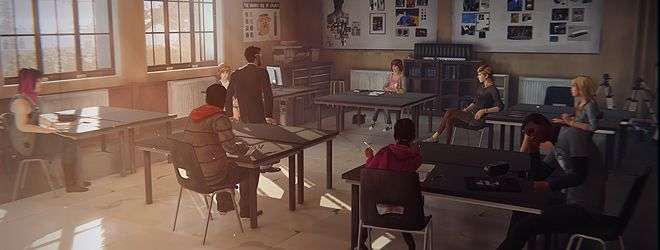Life Is Strange: Episode 1 – Chrysalis – Review
by Adam B
 I don’t really like reviewing episodic games as standalone things without the context of the other parts, so please bear in mind that Episode 2 and beyond could be completely different to what I’ve played so far.
I don’t really like reviewing episodic games as standalone things without the context of the other parts, so please bear in mind that Episode 2 and beyond could be completely different to what I’ve played so far.
Are you now or have you ever been a teenager? If so, then you likely know how it feels to be awkward and insecure, to constantly question your decisions, and to have the power to rewind time. Wouldn’t it be cool if there were a game experience out there that allowed you to relive that experience without all the shame and self-loathing? Well, you’re in luck.
Clearly taking inspiration from Telltale’s seemingly endless procession of adventure games, Life Is Strange is an episodic, narrative-driven experience which casts you as Max, a gawky hipster teenager who runs around with a Polaroid camera and discovers very early on that she has the ability to rewind time and, possibly, see glimpses of the future. This allows you to make a dialogue or action choice, see what happens, and then rewind and try something different if you don’t like the way it ends up. While this might initially feel almost like cheating, it quickly becomes apparent that there’s rarely a perfect answer to anything, as whatever you choose to do (or not do) is likely to have consequences somewhere down the line. Now, whether or not those consequences are more meaningful than Telltale have managed in their games remains to be seen; they can certainly cause the story to diverge fairly significantly at points but if everything ends up at exactly the same point anyway at the end of Episode 5 it’ll still be a little disappointing.
You can rewind at any time, except when you inexplicably can’t because of plot restrictions, but the game will flag up “important” decisions with a little icon and with Max questioning her choice in her internal monologue. Having the time rewinding as a thing that’s happening to Max and not just an abstract gameplay mechanic opens up a lot of interesting places for the story to go that wouldn’t otherwise be possible. It’s a nice system and I found I actually agonised over some of the decisions far more than I did in something like The Walking Dead because I wasn’t on a timer and I could just keep swapping back and forth second-guessing myself about what the “right” thing to do was, much as I did throughout my teenage years (and young adult years. And while writing this).
 The story of the first episode follows a number of threads; Max has returned to her hometown of Arcadia to study photography under famous ’90s photographer Mr. Jefferson, after moving away several years previously to attend an art school. Tied in with this are her attempts (or lack thereof) to reunite with her childhood best friend Chloe, whom she lost contact with after leaving, the disappearance of another student named Rachel, and the slightly creepy attempts by the school security guard to turn the campus into a totalitarian surveillance state.
The story of the first episode follows a number of threads; Max has returned to her hometown of Arcadia to study photography under famous ’90s photographer Mr. Jefferson, after moving away several years previously to attend an art school. Tied in with this are her attempts (or lack thereof) to reunite with her childhood best friend Chloe, whom she lost contact with after leaving, the disappearance of another student named Rachel, and the slightly creepy attempts by the school security guard to turn the campus into a totalitarian surveillance state.
How much you get involved in these events is largely up to you; there are key plot points that you’re always going to hit, but by and large you can just ignore a lot of the little side stories if you don’t want to get involved, although you will obviously miss out on a lot of content if you choose to do that. I found that my second time through I was much more thorough in making sure I talked to everyone and examined everything in case I’d missed some key part of the story first time around.
Life Is Strange doesn’t seem to be able to decide when it is, although it’s clearly set in the present day as everyone has laptops, USB sticks, uses social media, but there are also lots of CD players and Twin Peaks references and teenagers with boxes of photos under their beds. It feels like a modern setting that desperately wanted to cram in as much late ’80s/early ’90s nostalgia as possible and, to be honest, it mostly does a decent job if you don’t think about it in too much detail.
Sadly, the same can’t be said about the dialogue; one of the nice things about the game is that most of the main characters are fairly believable women, but the downside to that is the script feels very much like some adult men trying to imagine how teenage girls talk to each other, which isn’t a huge leap as the lead writers are both adult men. For the most part, Max is pretty well written but some of the other characters have lines that are downright painful to hear, and that’s not just because some of the voice acting is pretty shonky. I know – small studio, limited resources etc, but it doesn’t stop it from being immersion-breaking and occasionally laughably bad, and others have done much better with the same or fewer resources.
 The music is all very airy indie guitar fare which may well be de rigueur amongst teenage girls in the Pacific Northwest of America, but it doesn’t really do it for me. I mean, there’s nothing wrong with it really and it fits with the aesthetic, it’s just that sometimes it makes you wish that people would cheer the fuck up for a bit; even when they’re singing and dancing the backing track makes the whole thing feel like someone’s kitten has just died.
The music is all very airy indie guitar fare which may well be de rigueur amongst teenage girls in the Pacific Northwest of America, but it doesn’t really do it for me. I mean, there’s nothing wrong with it really and it fits with the aesthetic, it’s just that sometimes it makes you wish that people would cheer the fuck up for a bit; even when they’re singing and dancing the backing track makes the whole thing feel like someone’s kitten has just died.
Square Enix have taken an interesting approach to how Life Is Strange is sold; you can buy the whole five-episode series for £15.99 or you can just buy Episode 1 for £3.99 and then later buy Episodes 2-5 for £13.99. Sure, it means that if you just want to try out Episode 1 to see if it’s any good and then end up springing for the whole series you have to pay £1.99 more than if you buy it outright at the start, but I like having the choice. In fact, I probably wouldn’t have played the game at all if I’d had to pay £16 up front.
All in all, Life Is Strange is a smart, interesting, and occasionally touching take on the otherwise fairly static adventure game genre with what could generously be described as some patchy dialogue and voice acting. I’m looking forward to Episode 2 and if they can maintain the level they’ve set so far and maybe improve their writing a bit then it could become a serious competitor to the increasingly stale-feeling Telltale formula.
Pros- Lovely art direction
- Interesting cast
- In-world time manipulation is used to good effect
- Really makes you agonise over every decision
- Dialogue and voice acting is often poor
- Music can get annoying after a while
- Plot restrictions on rewinding can feel a little cheap
Life Is Strange is an interesting take on a genre that has recently been dominated by Telltale, HD remakes, and not a lot of innovation. It takes an interesting premise and executes it well to tell a good story and really makes you feel invested in your decisions. The writing is inconsistent and although the voice acting isn't the best, if you can look past that there's the makings of a great adventure game underneath.
Last five articles by Adam B
- Deus Ex: Mankind Divided - Review
- No Man's Sky - Review
- The Curious Tale of The Consoles That Became PCs
- Quality of Life
- Why You Should Be Watching Dota 2 Right Now

























There are no comments, yet.
Why don’t you be the first? Come on, you know you want to!